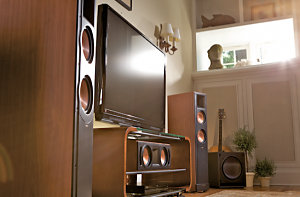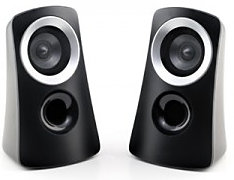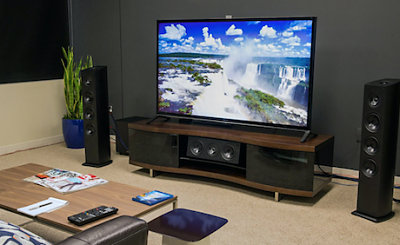Beginner Guide to Buying Home Theater Speakers

Tired of listening to those action sequences through your TV’s thin-sounding, built-in speakers?
We don’t blame you.
The next step to upgrade your sound is to buy home theater-level speakers. It can seem confusing at first, but we’re going to take the mystery out of it. (Mystery belongs in movies—not buying speakers!)

In this article, we’re going to cover:
- What kinds of speakers are available
- How to choose the right setup for your needs
- How to connect your speakers
- How to match your speakers to your home theater system
Let’s start with the basics:

Image source: crutchfield.com
In a standard home theater setup, you’ll find these speakers:
- One central channel speaker: This is the speaker that is responsible for 50% of a movie’s soundtrack and carries the majority of the dialogue. You’ll want to make sure you set this up at ear level for the best sound results.
- Front right and left speakers: These speakers reproduce a movie’s musical score and carry the bulk of special effects. The sound moves between the front speakers in sync with the action in the scene. Bookshelf, on-wall or floor-standing can all be used as front speakers. Floor-standing models are generally best for listening to music.
- Left and right surround speakers. These go behind/beside your seats, placed high enough so they are above your ears. They can be put on stands or sit on a shelf. The purpose of surround speakers is to provide the ambient atmosphere of a movie’s sound. You’ll hear noises like falling rain, passing cars and other general background noises that make you feel like you’re in the scene.
- Subwoofer. A powered subwoofer adds a full bass sound to a system. It’s what makes those explosions and car chases seem like they’re happening in your living room. If you have a smaller room, a compact subwoofer will probably meet your bass needs. If your room is larger, maybe consider a 12” woofer or larger. Some people even connect two subs to their system, but usually one will do the job just fine.
Home theater systems with these speakers are called a 5.1 surround sound system (5 speakers plus 1 subwoofer). There’s also a 7.1 surround sound setup which includes everything in the 5.1 system, but with two additional surround speakers.
Sound bars take the speakers you find in a home theater system and pack them into a unified design—usually a thin horizontal speaker with a separate subwoofer. They are usually less expensive and easy to set up, but due to their smaller size they don’t fill a room with sound as well as separate speaker systems.
Choose a setup that fits your needs
Do you mostly listen to music, and maybe watch the occasional movie? Or do you watch movies multiple times a week?
If you primarily listen to music and you don’t watch many movies, two floor speakers or a sound bar might best fit your needs, especially if you have a small room.
But if you have room to work with, and you’re a movie buff who wants a theater-like sound experience, you’ll want a 5.1 or 7.1 home theater system.
Pick the best speaker connection method
All speakers (but not sound bars) connect to a receiver, which is the device that controls your sound system. Receivers have built in amplifiers, which provide power to your speakers.
Some audiophiles prefer a separate amplifier to power their speakers for the highest sound quality, but for most people, a receiver will work just fine.
Speakers connect to a receiver in three ways:
- WiFi: If convenience and great sound quality are important to you, go with WiFi speakers. While it It’s the most expensive wireless connection option, it offers the best range and sound quality. It’s also very convenient because you can set WiFi speakers in different rooms and control the sound from your mobile devices. The only downside is that if you exceed your WiFi’s bandwidth, the sound quality will decrease.
- Bluetooth: If convenience, low cost and good sound quality are important to you, go with Bluetooth speakers. Most audio sources already have the ability to sync with Bluetooth, so that makes it a convenient wireless connection. Bluetooth speakers are less expensive than WiFi speakers, and they work well when your setup is contained in one room. However, Bluetooth has a limited range, so you won’t be able to connect speakers in different rooms.
- Speaker cable: If the best possible sound quality is most important to you, wired speakers are right for you. Audio professionals recommend a wired system for the best sound quality, but it’s also expensive to install. It’s also inconvenient because you’ll need to open up your ceiling and walls to hide the cables.
Make sure your speakers match your home theater setup

Image source: digitaltrends.com
Before you buy, make sure you take these factors into consideration:
- Receiver compatibility: To prevent any damage to your equipment, you’ll want to make sure your receiver or amplifier is providing power to your speakers effectively and safely. To do this, match your speakers’ ohms (the measurement for impedance) to those of the amplifier or receiver you’re buying. This prevents distortion and overheating, which can both damage your equipment. For example, you want to match 8-ohm speakers to an 8-ohm receiver. Most speakers are rated 8 or 6 ohms. You can find the ohm rating for a speaker or receiver on its back panel or in the instruction manual.
- Choose speakers of the same brand: Speakers of the same brand usually have a particular “voice” or sound to them. Keeping your system’s speakers within the same brand gives the best sound quality.
- Room space: If you have a smaller room to put your speakers, that will affect the type of speakers you buy. You can buy bookshelf speakers that can sit on a TV stand or media shelf, but keep in mind that if you put them behind furniture, it will decrease the sound quality.
- Decor: If the speakers in a home theater system don’t match the look and feel of your room, you’ll probably always regret having bought them.
Want more home theater advice?
Whether you’re just looking for advice or you have a home theater system you’d like installed in your Atlanta area home, we’re here to help. Call or drop us a line, any time.
Related articles
Related Reading
Subscribe To Our Newsletter
Get up-to-date current news, promotions, and industry tips.
